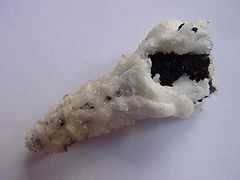Birnessite
| Birnessite | |
|---|---|
 | |
| General | |
| Category | Oxide mineral |
| Formula (repeating unit) | (Na0.3Ca0.1K0.1)(Mn4+,Mn3+)2O4·1.5H2O |
| Strunz classification | 04.FL.45 |
| Dana classification | 07.05.03.01 |
| Identification | |
| Color | Dark brown to black |
| Crystal habit | Rarely in platelets, to 50 μm; commonly extremely finely crystalline, spherulitic, cellular. |
| Crystal system | Monoclinic prismatic (pseudohexagonal) 2/m |
| Cleavage | [001] perfect |
| Mohs scale hardness | 1.5 |
| Luster | Sub-metallic, dull |
| Diaphaneity | Nearly opaque |
| Specific gravity | 3.0 |
| Optical properties | Uniaxial (-) |
| Refractive index | nω = 1.730 nε = 1.690 |
| Birefringence | δ = 0.040 |
| Other characteristics | Identification by optical properties is impossible. |
| References | [1][2][3] |
Birnessite (Na0.3Ca0.1K0.1)(Mn4+,Mn3+)2O4 · 1.5 H2O is an oxide mineral of manganese along with calcium, potassium and sodium. It has a dark brown to black color with a submetallic luster. It is also very soft, with a Mohs hardness of 1.5. Birnessite is formed by precipitation in lakes, oceans and groundwater and is a major component of desert varnish and deep sea manganese nodules.
History
It was first described in 1956 and named for an occurrence in Birness, Aberdeenshire, Scotland. Birnessite is found as an oxidation product of several other minerals, including rhodonite, rhodochrosite, and as a weathering product of franklinite-wilminite ore. It has also been found as a coating along joint planes and fractures within a trachyte sill. However, it has been most commonly seen as a constituent of oceanic nodules of manganese.
A recent study found that the mineral is able to break down prions via oxidation. How well this process works outside the laboratory is unclear.[4]
Geologic occurrence
Levinson[5] noted the presence of Birnessite in one or more mines from the region around Zacatecas, Mexico, while other notations have been made in Canada, at Cummington, Massachusetts, from the aforementioned nodules in both the Atlantic and Pacific Oceans, from the Tachaki Mine in Japan, the Treburland Mine in Cornwall, England, and from a bog in Norway.[6]
Composition and structure
Birnessite is a phyllomanganate, which is a type of ferroalloy that contains a high proportion of manganese. While natural forms generally contain foreign ions (i.e. Na, Ca, K) they are considered non-essential and synthetic forms of the mineral can be produced without them. However, most of the synthetic versions of the mineral undergo significant water loss at temperatures below 100 °C. Its structure is thought to be similar to that of chalcophanite,[7] and has been modeled as such by Burns.[8] The structure itself consists of sheets of water molecules found between sheets of edge-sharing molecules of MnO6 octahedra, and repeated on an average of every 7.2 Å, doing so along the c-axis. Of the six octahedral sites in the MnO6 octahedral layer, one is left unoccupied; Mn2+ and Mn3+ lie above each vacant slot on the octahedral. These Mn ions are low-valence, and associate with O, in both the octahedral and in the water sheets.[9]
See also
Other manganese oxides:
References
- ↑ http://www.handbookofmineralogy.org/pdfs/birnessite.pdf Handbook of Mineralogy
- ↑ http://www.mindat.org/min-680.html Mindat with location data
- ↑ http://www.webmineral.com/data/Birnessite.shtml Webmineral data
- ↑ http://www.sciencedaily.com/releases/2009/01/090114142028.htm Common Soil Mineral Degrades The Nearly Indestructible Prion
- ↑ Levinson, A.A. (1962) Mineralogical Notes,. The American Mineralogist Vol 47, May–June, (1962)
- ↑ Nicholson, K. (1988) Mineralogical Notes. Mineralogical Magazine, June (1988) Vol. 2 p. 415-417
- ↑ Holland K.L., and Walker, J.R. Crystal structure modeling of a highly disordered potassium birnessite. Clays and Clay Minerals. (1996) 44, 61, 744-748
- ↑
- ↑ Johnson, E.A., Post, J.E. Water in the interlayer region of birnessite: Importance in cation exchange and structural stability. American Mineralogist April (2006), v. 91 no.4 p. 609-618.
| ||||||||||||||||||||||||||||||||||||